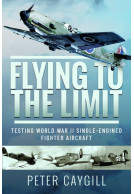Javelin from the Cockpit (ePub)
Britain's First Delta Wing Fighter
Imprint: Pen & Sword Aviation
File Size: 7.5 MB (.epub)
ISBN: 9781781599402
Published: 25th January 2012
| Other formats available - Buy the Hardback and get the eBook for free! | Price |
|---|---|
| Javelin from the Cockpit Hardback Add to Basket | £19.99 |
The Gloster Javelin was designed to be a night/all-weather fighter. It was first introduced into RAF service in 1956 and was retired in 1967. It was a large two-man, twin-engined and delta-winged aircraft. Although extremely rugged in construction pilots were banned from spinning as test flights had proved it impossible to recover. During its service nine different marks were introduced. At first it was armed with four wing-mounted cannon but as technology advanced air-to-air missiles supplemented them. In its role as a night/all-weather fighter it bristled with Britain’s latest radar and interception devices.
This book follows the theme of the ‘from the cockpit’ series and includes development history, the different marks and their subtleties, radar and weapon capabilities, accidents and incidents and many first-hand aircrew experiences of the type.
The Gloster Javelin was the first delta wing fighter to enter RAF service, and was designed as an all-weather fighter that could replace the later marks of Meteor as a night fighter. It entered service in 1956 and remained in use for over a decade, although never actually entered combat during that period.
ww2 Connection
This book covers the entire history of the Javelin, from its original design and development, through its introduction into service, the development of different marks of the aircraft and its last use in RAF service in the Far East.
There is a focus on the accidents, crashes and other disasters that befell individual aircraft, which rather gives the (perhaps unfair) impression that the Javelin was a rather unreliable aircraft. I suspect this apparent emphasis on the accidents has more to do with the Javelin's lack of a combat record, leaving the accidents and crashes as the main break in the peacetime routine of the Javelin squadrons.
The book has some interesting sections on the way in which fighter operations changed in the jet age. The frantic nature of the Second World War interception had been replaced with a much more careful process. The high speed of aircraft meant that warning times were low. The Javelin lost a significant amount of speed in a turn and didn't accelerate quickly, so each interception had to be very carefully planned to make sure the fighter ended up in the right position and with enough fuel left to get home.
This book follows the theme of Pen & Swords “from the cockpit” series and includes development history, the different marks and their subtleties, radar and weapon capabilities, accidents and incidents and many first-hand aircrew experiences of the type.
Britain at War Magazine
About Peter Caygill
Peter Caygill is one of Britain's foremost aviation historians. His careful research includes meeting many pilots and aircrew who can relate first-hand experiences of flying the aircraft in question. Peter's previously published books include Lightning from the Cockpit published by Pen & Sword and the Airlife Combat Legend Series - Focke Wulfe FW-190, Spitfire Mks I-V and Spitfire Mks VI - F.24 and also Jet Jockeys and Spitfire Mk V in Action.




















